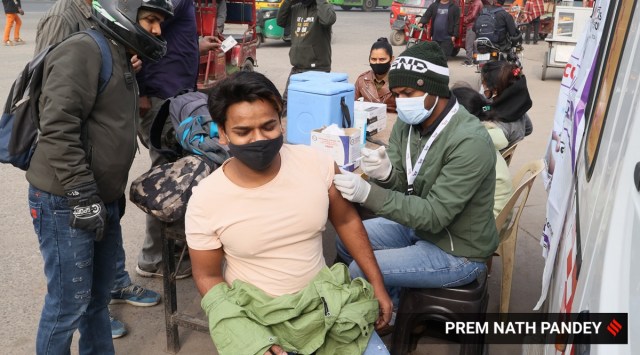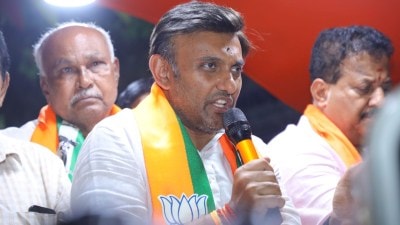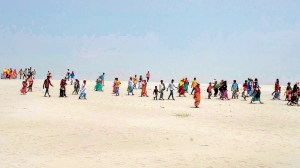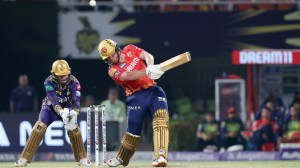- India
- International
70% adults twin-jabbed, younger kids could be part of coverage
🔴 While achieving saturation coverage of the adult population as well the 15-18 age group continues to be the priority, the government is looking at two new engagements in the Covid vaccination drive over the coming weeks, The Indian Express has learnt.
 About 46% of adolescents aged 15-18 years have received their first dose less than two weeks after vaccines were rolled out for them on January 3.
About 46% of adolescents aged 15-18 years have received their first dose less than two weeks after vaccines were rolled out for them on January 3.Seven out of 10 adults in the country have received two doses of the Covid-19 vaccine, as India completed one year of the world’s largest vaccination drive on Sunday.
While achieving saturation coverage of the adult population as well the 15-18 age group continues to be the priority, the government is looking at two new engagements in the Covid vaccination drive over the coming weeks, The Indian Express has learnt.
One, exploring further the scientific data on the “mixing” of vaccines and, two, considering vaccination for children of age younger than 15.
Top government sources said the National Technical Advisory Group on Immunization (NTAGI), which provides scientific inputs for the government’s vaccination policy, will be examining the advanced clinical trial data on using a vaccine based on a platform different from the first two doses, for the third, “precaution” dose in the 60-plus age group.
“The primary work that NTAGI is doing at present is looking at a heterologous regimen within the existing groups which have been permitted precaution doses. Because that is where the clinical trials within the country are at an advanced stage,” a senior government official said.

“The working group on Covid-19 within NTAGI is in close contact with the institutions conducting the heterologous clinical trials. Maybe data would be submitted to the drugs controller general by the end of January,” the official said.
The sources also said that the government would look at lowering the age floor for the vaccination of children once a “substantial part of the 15-18 group” is covered.
“NTAGI has given a generic recommendation on vaccinating children starting from the older ones. They have said that you can cover in a staggered manner, top downwards. Within that recommendation, the government took the decision that first, the 15-18 group would be covered. Once we have vaccinated a substantial part of the 15-18, we will lower the age limit,” a top source said.
About 46% of adolescents aged 15-18 years have received their first dose less than two weeks after vaccines were rolled out for them on January 3.
On Sunday, Prime Minister Narendra Modi said India’s vaccination programme had added great strength to the battle against the coronavirus, and praised the role of frontline workers in the drive.
As cumulative vaccinations touched 157 crore, Modi posted on Twitter: “Today we mark #1YearOfVaccineDrive. I salute each and every individual who is associated with the vaccination drive. Our vaccination programme has added great strength to the fight against Covid-19. It has led to saving lives and thus protecting livelihoods.”
According to official estimates, 92% of the eligible adult population has received the first dose of the vaccine, and 70% have received both doses.
“…The role of our doctors, nurses, and healthcare workers is exceptional. When we see glimpses of people being vaccinated in remote areas, or our healthcare workers taking the vaccines there, our hearts and minds are filled with pride,” Modi tweeted.
India completes a year of its vaccination drive — the first shots were administered on January 16, 2021 — amid the Omicron surge: on Sunday, the country’s active caseload touched 15.50 lakh, and the weekly positivity rate was close to 14%. Third “precaution” doses of the vaccine are being given to vulnerable sections of the population — 17.92 lakh healthcare workers and 14.45 lakh frontline workers have received the precaution dose, according to official data.
Modi underlined the imperative of continuing to follow all Covid-19 protocols. “India’s approach to fighting the pandemic will always remain science-based,” he said. “We are also augmenting health infrastructure to ensure our fellow citizens get proper care. Let us keep following all Covid-19 related protocols and overcome the pandemic,” he tweeted.
While some high-performance states have pushed to achieve saturation first- and second-dose coverage, some continue to report vaccination coverage below the national average.
According to official data, Andhra Pradesh (72%) and Bihar (82%) are large states reporting first-dose coverage below the national average. Six large states are reporting second-dose coverage below the national average: Uttar Pradesh (57%), Andhra Pradesh (59%), Bihar (62%), Maharashtra (64%), West Bengal (64%), and Tamil Nadu (65%).
Newsletter | Click to get the day’s best explainers in your inbox
Among mid-sized states, two are reporting below-national-average-coverage for both the first and second doses: Jharkhand (75% and 47% respectively) and Punjab (81% and 48% respectively).
Four Northeastern states are reporting low first-dose coverage: Nagaland (50%), Manipur (69%), Meghalaya (61%), and Arunachal Pradesh (85%).
Four large states are reporting second-dose coverage above the national average: Gujarat (94%), Madhya Pradesh (92%), Karnataka (86%), and Rajasthan (73%).
There are five mid-sized states in this category: Telangana (94%), Haryana (79%), Kerala (77%), Assam (73%), and Odisha (72%).
“The entire world community is surprised with our efforts in fighting the Covid pandemic. Despite having a high density of population, we have been able to administer more than 156 crore Covid-19 vaccine doses. India has encountered various challenges along the journey but it is the resolve and dedication of more than 135 crore people that we could overcome every challenge,” Union Health Minister Mansukh Mandaviya said.
“Credit goes to our indigenous research and development and streamlined production and distribution of vaccines. Amidst the environment of criticism and disbelief, the country gathered its spirits and worked against those who wanted to spread doubts and misinformation against indigenous vaccines and create vaccine hesitancy,” he said.
Apr 27: Latest News
- 01
- 02
- 03
- 04
- 05































